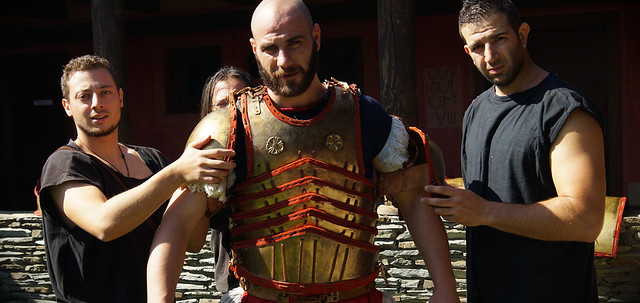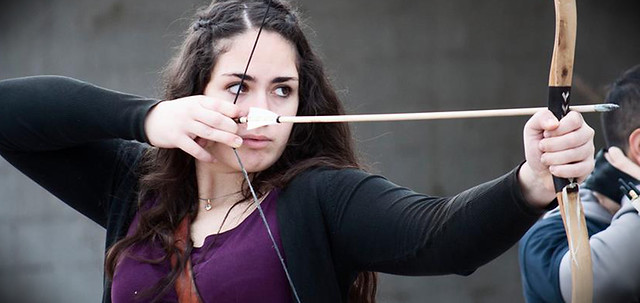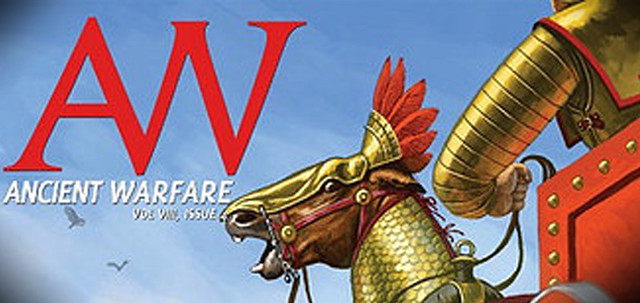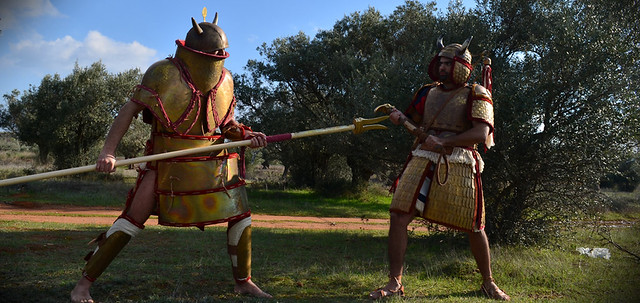Modern reconstruction of 13th cent Byzantine officer . Equipment courtesy of living history association Koryvantes and hellenicarmors.gr
In the proto-Byzantine period, the inhabitants of the Empire’s urban areas were organized in groups along the lines of the Circus Fractions. These groups were called “Deimoi” and were headed by leaders called “Democrats”. These groups were organized as paramilitary formations with policing and military tasks. Among their tasks were keeping the city clean, performing fire service and the burial of the dead from the epidemics or war. Because they were not considered reliable in open battle, their main role during wartime, was the defense of the city walls in case of siege.
Modern reconstruction of 6th cent urban militiaman HIs blue tunic marks him as a member of the “Blues Circus Fraction”. The double head eagle though appeared after the 14th century.
The inhabitants of the Constaninopolis urban are inside the walls were called “Politicoi” and residents of the suburbs (the area beyond city walls was called “Peran” ) were called ‘”Peratikoi”. Procopius states that in Antioch the militiamen were better equipped than those of the capital -perhaps because of more lax Imperial supervision. After the “Nika Revolt”, their strength was limited, in order to prevent possible future rebellions.
Modern reconstruction of an urban militiaman from Antioch. He is wearing a military tunic and his blue trousers set hims as a member of the “Blues Circus Fraction”. According to Procopious the Antiochian militia was well armored. Armor courtesy of living history association Koryvantes and hellenicarmors.gr
The Arab invasions of the seventh and eighth centuries brought changes to the system of the Empire’s defense. At the points where covering crossings and passage ways were built small towers called “vigla” and were manned by local guards called “viglatores”. The viglatores were responsible only for their area and did not follow the regular army on campaigns. Their mission was more supplementary to the light cavalry “Akritae” frontier units. The upsurge of piracy in the Eastern Mediterranean brought the vigla institution and to the Aegean Islands and Cyprus.
Modern reconstruction of a 7th cent viglatoras from the . Probably the last in the pickets line as he would sound the alarm by blowing the horn . Uniform and horn courtesy of the living history association Koryvantes and boots courtesy of hellenicarmors.gr
The viglatores were aged between 17 and 50 years of age and were trained in the use mainly of projectile weapons and in the art of sending signals. Chosen by the elders of the nearby villages. Their mission was to whether armed enemy groups or ships passed from their area of responsibility. Signals were transmitted from one vigla to another, thus putting the local military forces on alert, while with appropriate signals the inhabitants of the region were also alerted in order to seek refuge in fortresses or caves together with everything that could be useful to the enemy (e.g. food or tools).
Modern reconstruction of an 8th cent viglatoras based on frescoes from Cappadocia. Armor courtesy of living history association Koryvantes and hellenicarmors.gr
During 14th century Byzantine Empire decayed rapidly. The social fabric had been destroyed and the State was at the whim of foreign mercenaries that was unable to pay. The only positive thing was the consolidation of the Empire’s position in Peloponessos and the repulse of the Catalan Company assault in Thessaloniki. Technological lead in weapons had passed to the hands of the Westerners.
Modern reconstruction of 14th cent Byzantine Militia officer based on contemporary frescoes from Ochrid. The helmet shows western influence. Armor and boots courtesy of living history association Koryvantes and hellenicarmors.gr.
The final end came in the 15th century. Unable to exploit the problems of the Ottomans after the battle of Ankara, the Empire gradually lost territories to them and even Constantinople itself was found in the first line of Turkish attacks. The few regular soldiers and militiamen had not been adequately prepared to prevent the Ottoman army to finally destroy the Byzantine Empire in 1453.
Modern reconstruction of 15th cent Byzantine archer based on contemporary icons of the Crucifixtion. The helmet shows western (italian) influence and it is based on findings from ”Chalcis Armory”. The double head eagle though is again unlikely as it was strictly an imperial family emblem and chroniclers talk about a double lion emblem. Armor and boots courtesy of living history association Koryvantes and hellenicarmors.gr
SOURCES
The Cambridge History of the Byzantine Empire c.500–1492 translated by MELISSA publications 1966
Osprey Military publishing Co: “Romano-Byzantine Armies 4th-9th cent”
Gwatkin, H.M., Whitney, J.P. (ed) et al. The Cambridge Medieval History Cambridge University Press, 1926.
Forbes, Townsbee, Mitrany, Hogarth “The Balkans: A history,of Bulgaria Serbia Greece, Rumania, Turkey” Oxford University press 1915
A History of the Byzantine Empire by Al. Vasilief Translated from the Russian by S. Ragozin, Madison 1928
Edward Gibbon’s Decline and Fall of the Roman Empire 1782 (Written), 1845 (Revised)
John Haldon Byzantium at War Osprey ISBN: 0415968615





Δεν υπάρχουν σχόλια:
Δημοσίευση σχολίου